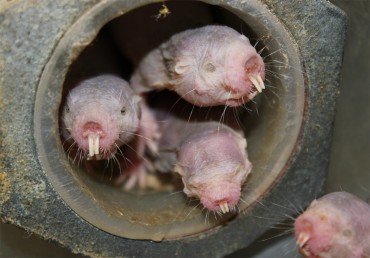African mole-rats immune to ‘wasabi pain’
A new report in Science provides the first evidence of a mammal — the highveld mole-rat — being immune to pain from exposure to allyl isothiocyanate, or AITC, the active ingredient of wasabi.
The scientists who studied the animals say that understanding how these African rodents evolved to be insensitive to this specific type of pain could point to new directions for solving pain in humans.
“Mole-rats are extremely curious animals and we have been studying them at UIC for more than 20 years,” said study co-author Thomas Park, professor of biological sciences at the University of Illinois at Chicago College of Liberal Arts and Sciences. “This new discovery — that they have evolved to be insensitive to certain pain stimuli common in their environment — is another example of the cool biological lessons to be learned from studying them.”
Park worked alongside scientists from the Max Delbruck Center for Molecular Medicine in Berlin and the University of Pretoria in Pretoria, South Africa, on the study. The research was conducted at UIC and in South Africa.
They exposed the paws of eight species of mole-rats to three compounds that induce a pain-like response — AITC, an acidic solution with a pH similar to lemon juice and capsaicin, the spicy ingredient in chili peppers. The scientists monitored behaviors, such as the time an animal spent licking its paws after being exposed to a small drop of the chemicals. They compared these observed behaviors with those they observed in mice when exposed to the same compounds. Following euthanasia, the scientists also extracted spinal cord tissue and nerve tissues for analysis.
Three of the species were immune to the acidic solution and two were immune to capsaicin, but the naked mole-rat was the only species immune to both.
They also found that the highveld mole-rate was immune to exposure to the AITC compound.
“This is an awesome finding because the highveld mole-rat is the only mammal known to be immune to ‘wasabi pain,'” Park said. “It turns out that highveld mole-rats share their tunnels, their natural environment in Africa, with a stinging ant species, the natal droptail ant. The ant’s sting normally activates the same pain receptors that respond to wasabi. Over time, the highveld mole-rats evolved to become unaffected by the sting.”
Park and his colleagues also analyzed genetic materials from the samples they took from the mole-rats and found that the nerves of highveld mole-rats had an unusually large number of tiny structures called leak channels on their surface.
“Nature and evolution solved a pain problem for the highveld mole-rat. The leak channels make the nerves unable to convey messages about wasabi pain to the brain,” Park said. “Instead of delivering the signal from the receptor to the brain, the leak channels divert the signal.”
The researchers say that this finding is particularly interesting, as the evolutionary change for this species of mole-rate occurred over a short period of time — 7 million years. The naked mole-rats also developed their immunity to the acidic solution and capsaicin quickly.
“That may seem like a long time, but in evolutionary biology, 7 million years is considered to be quite rapid,” Park said.
“When we find out how to add leak channels to our own pain cells, we’ll have a new way of fighting pain, without the side effect of addiction from external pain killers,” he said.
This research was funded by grants from the National Science Foundation, the European Research Council and the Deutsche Forschungsgemeinschaft SFB 958.

